Can China sink all US carriers in 20 minutes?
Can China’s hypersonic missiles sink all US aircraft carriers in 20 minutes? This claim, made by US Defence Secretary Pete Hegseth at the end of last year when he was a Fox News TV host, has ignited debate. While experts dispute the 20-minute timeframe, the threat posed by China’s anti-carrier capabilities is real, intensifying the US-China military rivalry and fuelling an arms race. Lianhe Zaobao’s China Desk looks into the question.
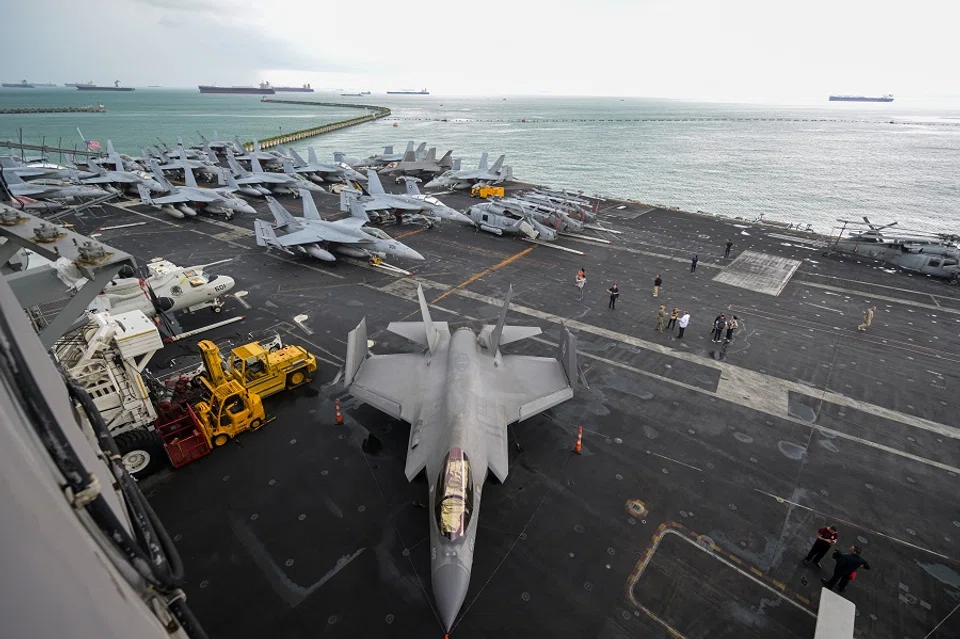
Can China’s hypersonic missiles destroy all of America’s aircraft carriers in 20 minutes?
Comments made by US Secretary of Defence Pete Hegseth at the end of last year have recently sparked fervent discussion among Chinese and American military buffs, with China’s Ministry of National Defence also responding last week.
Before becoming defence secretary in January 2025, 44-year-old Hegseth was a TV host on Fox News. As a guest last November on a podcast by former Navy SEAL Shawn Ryan, he warned that China is building a military force “specifically dedicated to defeating the United States of America”; that the People’s Liberation Army’s (PLA) hypersonic missiles could sink all of America’s aircraft carriers “within the first minutes of a potential conflict”; and that the US lost “every time” in all of the Pentagon’s simulated war games against China.

Hegseth asked on the show: “And if 15 hypersonic missiles can take out our 10 (sic: should be 11) aircraft carriers in the first 20 minutes of a conflict, what does that look like?”
These remarks were reported by multiple US media outlets in mid-April, reflecting growing worries on the Pacific east coast about the combat capabilities of China’s “carrier killers”.
China Central Television (CCTV) and military.china.com have noted that, as of March this year, only four of the US Navy’s 11 nuclear-powered aircraft carriers in commission were in a state of deployability.
China’s stand
In response to Hegseth’s comments, at a routine press conference on 24 April, Chinese defence ministry spokesperson Zhang Xiaogang levelled a veiled criticism without naming anyone. “Some individuals in the US see the Chinese military through coloured lens and keep hyping up the so-called ‘China military threat’. I think this is an obstacle hindering engagements between the Chinese and US militaries.
“Non-conflict, non-confrontation and peaceful coexistence is in the most fundamental interests of both China and the US, and meets the common expectation of people across the world. We have a sober understanding of the state of our development. We hope the US side will break away from ‘persecution mania’ and stop using others as excuses.”
However, some media outlets feel that America’s world-dominating aircraft carrier fleet is actually showing signs of hidden weakness in recent years.
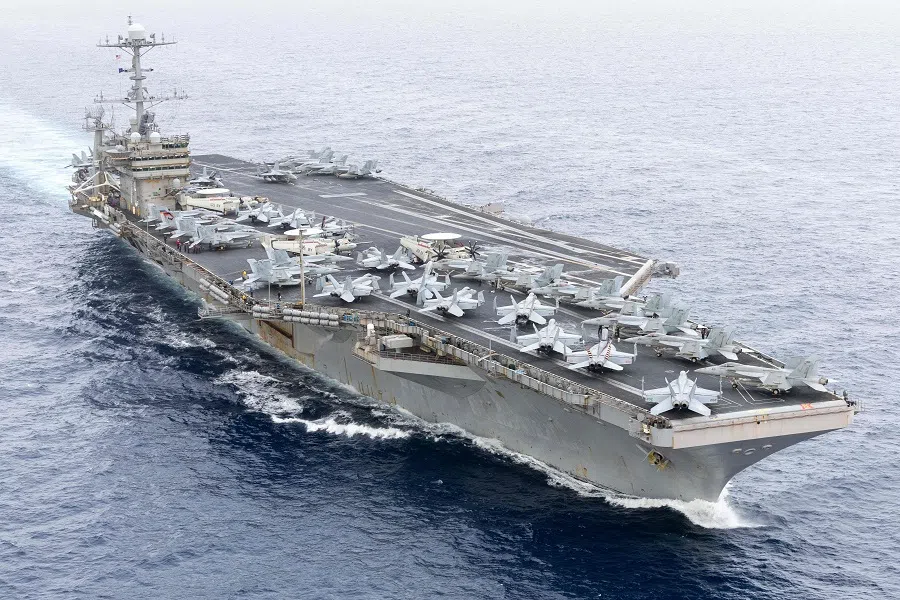
China Central Television (CCTV) and military.china.com have noted that, as of March this year, only four of the US Navy’s 11 nuclear-powered aircraft carriers in commission were in a state of deployability. As pointed out in the Washington Times report on 16 April on Hegseth’s claims, US carrier strike groups “currently have limited defences against hypersonic missiles”.
According to the report, China has “deployed two unique hypersonic missile systems that can fly at speeds greater than five times the speed of sound, and manoeuvre in striking targets in minutes while avoiding missile defences”.
China’s military progress
The Pentagon’s annual report on the Chinese military acknowledged that the PLA has made great progress with the DF-17 medium-range missile, which boasts a range of about 2,400 km. It can be armed with hypersonic glide vehicles and “used to strike foreign military bases and fleets in the Western Pacific”.
The DF-27, armable with a hypersonic warhead, has a range of about 8,000 km. Possible payloads for this missile include “land attack, conventional anti-ship, or nuclear warheads”.
Meanwhile, US satellite photos from recent years consistently reveal that China’s weapons testing ground in its northwestern desert features a mock-up of a US aircraft carrier as a target. This has intensified concerns within the US military that the PLA is rehearsing strikes against aircraft carriers.


As evident in satellite photographs procured in October 2021 by the American space technology company Maxar Technologies, the Chinese military’s new target range in the Taklamakan Desert in southwest Xinjiang showed full-scale mock-ups of US warships that could be used as training targets. The mock-ups included those of an aircraft carrier and at least two Arleigh Burke-class destroyers, both part of the US Seventh Fleet that sails through the Taiwan Strait.
Satellite images taken by the US commercial Earth-imaging company Planet Labs on 1 January 2024, also revealed a telling replica in the PLA’s Taklamakan Desert target range, constructed in November 2023 and modelled after America’s newest aircraft carrier, the USS Gerald R. Ford.
... the first-generation DF-21D, when carrying a high-explosive warhead and performing an overhead attack, can directly penetrate the deck of a US aircraft carrier, rendering it completely ineffective in combat. — Chen Guangwen, Military Commentator, Yangtse Evening Post
China public believes PLA capable of annihilating America’s aircraft carriers
Prevalent in the popular opinion in China is the belief in the PLA’s ability to annihilate America’s aircraft carriers.
In an essay published on 24 April, the Yangtse Evening Post’s military commentator Chen Guangwen observed that while statements from the US military’s top echelons may be exaggerated, they indirectly highlight the strong deterrent effect of China’s anti-access strategy and the significant upgrades to the PLA’s carrier-fighting capabilities; China’s anti-carrier weapons, as represented by the DF-21D, DF-26, DF-17 and other anti-ship ballistic missiles, have comprehensive strike capabilities.
According to Chen’s analysis, the first-generation DF-21D, when carrying a high-explosive warhead and performing an overhead attack, can directly penetrate the deck of a US aircraft carrier, rendering it completely ineffective in combat.
The second-generation DF-26, with a striking distance of over 4,000 km, reaches farther and hits with higher precision. Dubbed the “Guam Killer”, it is “enough to send all the American aircraft carriers within and beyond the Second Island Chain to the bottom of the sea”, says Chen.
The DF-17 is a hypersonic model. Thanks to its waverider warhead, this missile flies with a more unpredictable trajectory, such that it cannot be intercepted by any anti-missile system. When it is deployed against an aircraft carrier, the issue of it being intercepted is not a consideration at all.
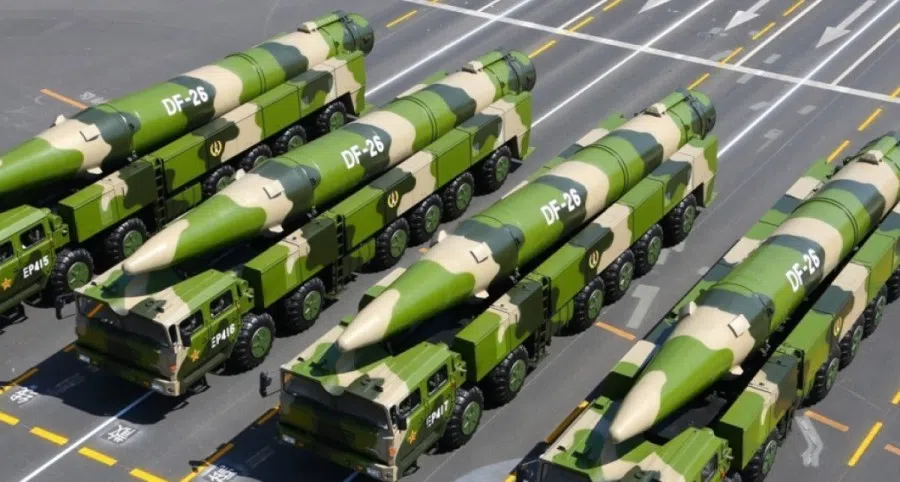
According to Chen’s assessment, there is actually more to China’s development of its anti-carrier operations than the advanced weapons mentioned above. The emphasis is on a mega-systemic approach. The synergy between drones, submarine vehicles, anti-ship cruise missiles, supercavitating torpedoes and pre-positioned smart mines, bolstered by strategic support across the warfighting domains of air, space, EMS and cyberspace, “is enough to make sure all US aircraft carriers do not make it back”.
The show suggested that Hegseth exaggerated the Chinese threat to secure a larger budget for the US military, forge a common understanding for alliance, and strengthen military cooperation with Japan, Australia and other allies.
In its episode of 25 April, the Chinese online military programme Crazy Warfare Show (CWS) downplayed the PLA’s scenario of the total annihilation of US aircraft carriers. The show suggested that Hegseth exaggerated the Chinese threat to secure a larger budget for the US military, forge a common understanding for alliance, and strengthen military cooperation with Japan, Australia and other allies.
This year, the Pentagon is seeking a military budget of US$6.9 billion, which includes funding for hypersonic missile research.
Goals of the PLA
One of the goals of the PLA’s efforts over the last 20 years or so has been to break through the first island chain and then win a local war close to China, preventing third-party external forces from mounting support operations in the Western Pacific, said CWS.
In an imagined scenario, the PLA may have to attack or even sink a foreign aircraft carrier or two (plus their flotillas) in such operations of area denial. However, when it comes to China sinking all of America’s carriers within 20 minutes, the show said China had never thought about it, adding that whether or not it is capable of doing so, the US could not possibly gather its entire fleet of 11 aircraft carriers in the Western Pacific.
CWS went on to assert that aircraft carriers are the most difficult warships to sink at sea. Back in 1946, the US had actually tested aircraft carriers’ resistance to nuclear explosions. In the tests, the USS Independence withstood the blast from a 23-kilotonne nuclear bomb detonated just 510 metres away, followed by a second nuclear bomb, this time underwater — the USS Independence did not sink.
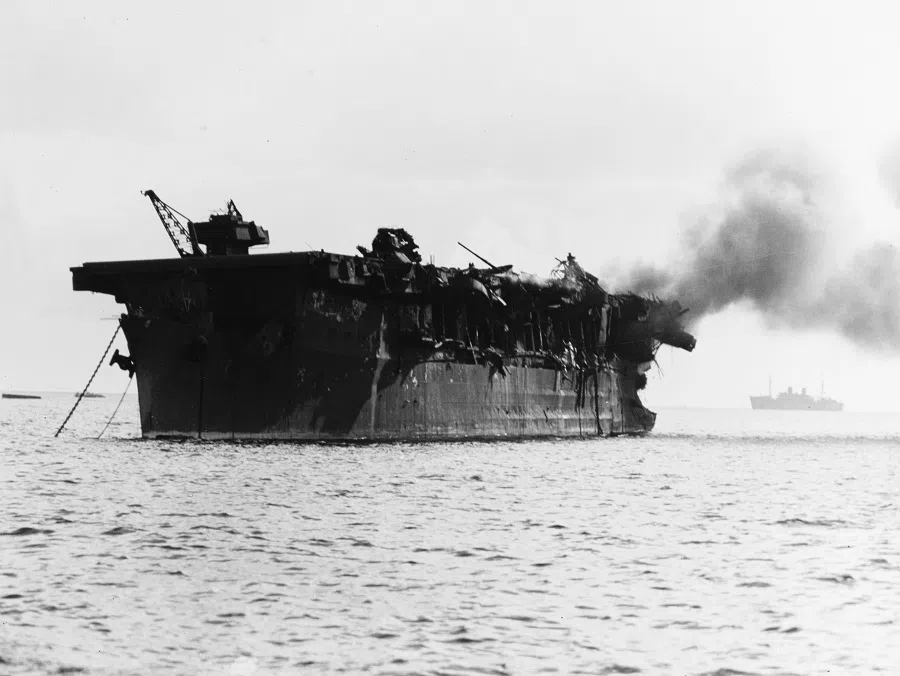
American aircraft carriers today are several times more strike-resistant than the USS Independence, and their special underwater armour is designed to make it difficult for underwater bombs or torpedoes to sink them through an attack beneath the water surface. Furthermore, a carrier fleet would usually be protected by warships, so it is not easy for regular torpedoes or missiles to hit an aircraft carrier.
... China has conducted in-depth research on ways to strike aircraft carriers, and in recent years has achieved breakthroughs in developing anti-carrier weapons and technologies — China is now the only country in the world to possess anti-ship ballistic missiles.
US message to the PLA
In June 2021, the situation in the Taiwan Strait got very tense between China and America. The US military made the rare move of releasing footage of a test explosion, showing how explosives powerful enough to set off the equivalent of a magnitude 4 earthquake were detonated next to the USS Gerald R. Ford, without causing any damage to the aircraft carrier hull. This was a repeat of an experiment by the US military after over 30 years; there was a strong sense of a warning being sent to the PLA.
However, aircraft carriers do have weaknesses. According to analyses, the most important combat capability of this kind of vessel lies in the flight deck, where the carrier’s island, aircraft catapults, landing aid system and other key facilities are concentrated. In order to ensure the proper weight balance of the ship, the deck itself is not heavily armoured. If the facilities on the deck are destroyed, the carrier would lose combat effectiveness and practically become just scrap metal. To break an aircraft carrier, it is more effective to attack from the air, without necessarily having to sink the vessel.
For a long time, China has conducted in-depth research on ways to strike aircraft carriers, and in recent years has achieved breakthroughs in developing anti-carrier weapons and technologies — China is now the only country in the world to possess anti-ship ballistic missiles.
According to CWS, the PLA’s cooperative engagement mode that brings together China’s carrier battle groups and Rocket Force is gradually maturing. Aircraft carriers such as the Shandong can provide target indication for the Rocket Force, while the YJ-21 anti-ship ballistic missiles carried by Type 055 destroyers can force the US aircraft carriers to stay at least 1,000 km away, creating a safer launch window for land-based missiles.
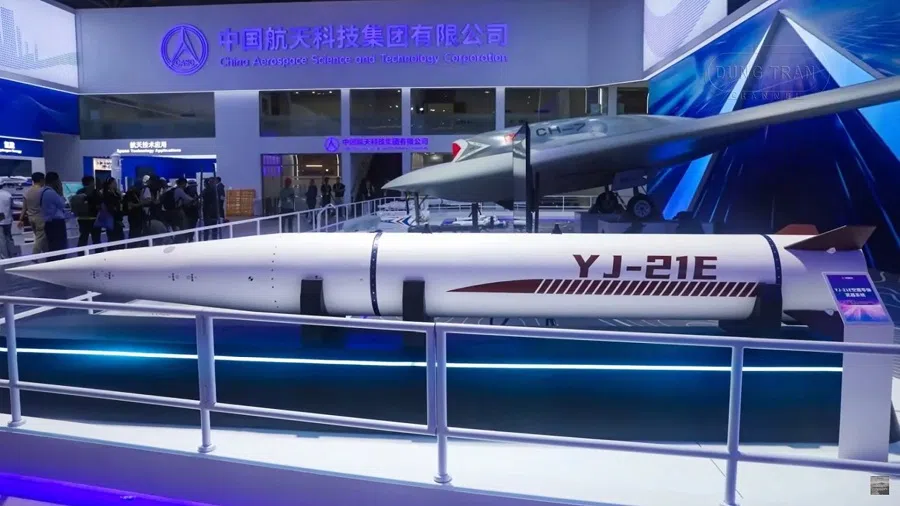
This air-launched ballistic missile, also known as a “carrier killer”, was unveiled by Chinese official media last November at the Zhuhai Airshow, mounted on a H-6K bomber — along with its name and footage of it being fired — underscoring China’s intention to display its anti-access combat capabilities to the US.
... mutual military deterrence between China and the US in the Western Pacific will continue to escalate over the next few years; the arms race and the battle for the defence of aircraft carriers will enter a more intense phase.
According to the US Department of Defense’s 2023 report on China’s military strength, the combination of the H-6K and the YJ-21 is enough to pose a threat to targets in the second island chain, while the interception of hypersonic missiles by the US military’s SM-6 air defence missiles is only a theoretical possibility.
A Voice of America report puts the range of the shipborne version of the YJ-21 at 1,000 to 1,500 km. Given that the F-35C fighters carried by US aircraft carriers have an operational radius of 1,100 km, this means that Chinese bombers are able to comfortably launch the critical missile from outside the US carriers’ air defence circle.
The US-China tariff war is currently the focus for Washington’s engagement with Beijing. Militarily speaking, the two countries are not yet at odds regionally in any prominent way, but at the same time, exchanges between the militaries of both sides are heavily hindered. Even though Hegseth is deeply embroiled in controversy at the Pentagon and his political future remains uncertain, we can be sure of two things: mutual military deterrence between China and the US in the Western Pacific will continue to escalate over the next few years; the arms race and the battle for the defence of aircraft carriers will enter a more intense phase.
This article was first published in Lianhe Zaobao as “中国能20分钟全歼美国航母吗?”.



![[Big read] Love is hard to find for millions of rural Chinese men](https://cassette.sphdigital.com.sg/image/thinkchina/16fb62fbcf055b710e38d7679f82264ad682ce8b45542008afeb14d369a94399)
![[Big read] China’s 10 trillion RMB debt clean-up falls short](https://cassette.sphdigital.com.sg/image/thinkchina/d08cfc72b13782693c25f2fcbf886fa7673723efca260881e7086211b082e66c)
